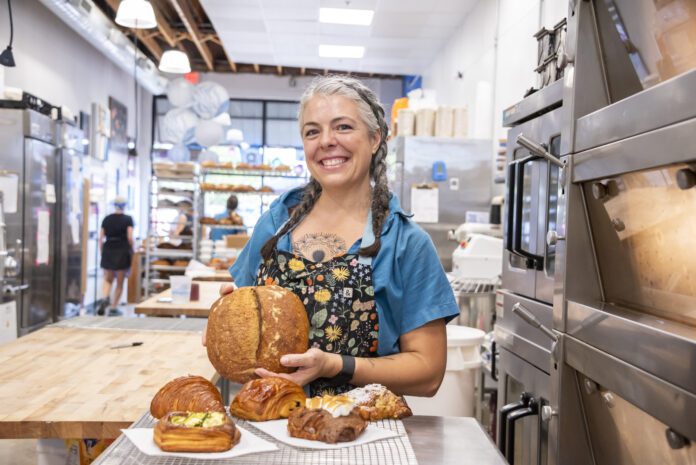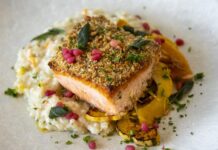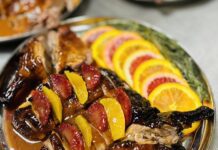
Early Saturday morning, rain or shine, in freezing snow or Saharan heat, a long line forms on a quiet stretch of Utica Avenue. Regulars are there by 8:00 a.m., laden with chairs, books and coffee. Their goal? Grabbing goodies from Cat Cox’s Country Bird Bakery, which is open only on Saturday morning, and which offers the most glorious, pillowy, crusty loaves of bread known to man. (And pastries too!)

Why don’t these people just run into a supermarket and grab a loaf?
“Manufactured bread,” says Cox, the lithe, friendly, energetic woman who spends the rest of the week preparing and baking the bread, “no human hands touch it. Roller milling strips it of nutrients and flavor. It’s a dead thing. Our bread is alive. It’s a community of microorganisms that create air bubbles, give it flavor, make it more digestible. Our bread has terroir.”
Terroir, the taste and feel of the local land, comes from the grains Cox gets from small farms. She uses old, heirloom varieties. John’s Farm, for instance, tilled by seventh-generation farmers, has a land race of winter wheat unique to Oklahoma. Some varieties of wheat, however, just don’t grow in Oklahoma, and Cox gets these from small-scale farmers in Texas. The wheat berries are made into flour by a small mill in Enid, where they are ground between two huge rotating stones.
To make that flour into bread, says Cox, is “a lot of work; it’s relentless.”
That work begins on Thursday, when she feeds and readies the starter. She makes sourdough, perhaps the oldest bread in history (archaeologists have found 6,000-year-old loaves), made from wild yeast, and her starter, a fermented mix of flour and water containing wild yeast and lactobacilli, is at least 20 years old.

On Friday morning, she mixes the dough (flour, water, starter and later, salt), stretches and folds it, again and again. The dough spends the rest of the day fermenting in big tubs. Then, divided into loaves, it’s refrigerated overnight and the yeast begins its work. All this requires perfect timing or the dough won’t rise right.
“It’s a dance of timing,” says Cox. “And it’s never the same. That’s why I’ve loved it for so long.”
And Cox has loved it for almost all her life. She grew up in Tulsa. Both her grandmothers baked, and her mother encouraged her to give it a try. She was making pretzels and cakes by elementary school. After graduating from Booker T. Washington, she went to art school, moved to New York and later Marfa, Texas. But while there, she found her way to restaurant kitchens – baking called her back – and when she returned to Tulsa, she made it her vocation.
Saturday, the big day, begins early. Cox arrives at the bakery at 3 a.m. Her staff of four comes in by 4 a.m. There are also croissants and pastry to be done. She started making those on Tuesday, creating the many thin layers and interleaving them with butter. By 9 a.m. Saturday, the nine kinds of bread and 20 varieties of pastry are on the shelves, the doors open, and the first of the 200 customers rush in.
“It blows me away,” says Cox. “I am so grateful to the people in line, it makes me feel I’m doing something right. I think they can tell the quality of our craft, which I and my staff have spent years honing. They can tell that we care about what we’re making. I always look at what we’ve made and think: ‘There’s no way we can sell it all.’ But they show up every week and we sell out. People tell me that my bakery could hold its own in any city in the U.S., and that makes me feel really proud.”
Cat Cox’s Tea Cake
Dries:
1 tsp. baking soda
1/2 tsp. baking powder
1 tsp. kosher salt
115 g. all purpose flour
115 g. whole wheat flour (spelt, rye, or sonoran)
2 tbsp. spices (cinnamon, nutmeg, sumac, coriander, ginger) blend amounts to your preferences
Wet:
200 g. sugar
1/2 cup olive oil
2 large eggs
1 tsp. orange zest
1/4 cup fresh orange juice or buttermilk
1 tsp. vanilla
1 cup fruit or vegetable puree (we like apples, beets, sweet potatoes, or pumpkin)
Instructions:
Pre-heat oven to 350 degrees.
Using non-stick spray or olive oil, coat a standard loaf pan and line with parchment paper.
In a medium bowl, combine dry ingredients.
In a separate medium bowl, whisk wet ingredients together.
Combine dry ingredients into wet, just until mixed.
Pour batter into greased pan and bake at 350 degrees for 40-45 mins.























